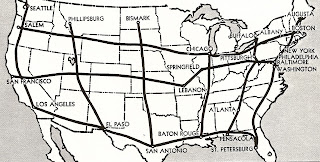The appearance of comic strip characters usually evolves from the first time they are shown until a definitive look is arrived at. The early Dick Tracy, Li'l Abner and Terry Lee (of Terry and the Pirates) were but wispy hints of the boldly-drawn evolved versions familiar to comic-strip buffs and those old enough to recall their heyday.
Occasionally, a character's look never quite settles down. Consider Wilma Deering, longtime girlfriend of Buck Rogers, the pioneering space-faring comic strip hero of "Buck Rogers in the 25th Century."
The Buck Rogers strip evolved from a science-fiction magazine story, appearing in newspapers early in 1929 (the Wikipedia entry on Buck Rogers is
here). The original artist was
Dick Calkins, an Army Air Service pilot and flight instructor in the Great War who went on to a career as a newspaper artist.
In my judgment, Calkins was never much of an artist, and the strip probably succeeded more on the novelty and glamor of space travel and strange other worlds (along with standard-issue swashbuckling in sci-fi guise) than in the quality of Calkins' drawing.
Eventually, Calkins' imagery became fairly consistent. But in the early months of the strip, the appearance of Buck, Wilma and supporting characters varied considerably. In fact, it almost seemed like more than one artist had a hand in the strip -- though as far as we know, help in the form of
Rick Yager didn't appear for another four years.
The Wikipedia entries above disagree as to when and to what degree Yager took over from Calkins. Yager had responsibility for the Sunday strips, and his style there was definitely different from that of Calkins by the 1940s. I'm inclined to agree with the Calkins entry that Calkins did the dailies as late as 1947 or so. That's based on drawing style. On the other hand, Yager was able to mimic the flowing style of "Lichty" in the Grin and Bear It cartoon, so perhaps he indeed drew dailies in the brittle idiom Calkins had evolved as the 1930s wore on.
Below are examples of Calkins' version of Wilma Deering, four from the first year of the stip, and one from ten years later.
Gallery
This is from the second-ever panel, in which Wilma encounters Buck for the first time. He had just emerged from a 500-year hibernation in a cave, that sleep induced by a mysterious gas.
Wilma hasn't evolved much at this early point. For example, she still seems to be a brunette, though her anatomy is drawn more surely.
The images above are in the same day's panel from a few months later. Calkins' artwork has improved. Characters' features edge towards the suggested, rather than the laboriously drawn. So far as I'm concerned, from an aesthetic viewpoint, the seated Wilma is the best that Calkins ever did. Since her depiction was inconsistent day-by day, week-by-week, I suppose that, statistically, Calkins had to nail it once in a rare while.
Here's Wilma probably from a mid-1930s panel. Calkins' style is now more harsh -- a brittle feel. This was probably just a natural evolution on Calkins' part, though it's possible he was urged to make bolder, darker, more structured images so that the strip would stand out better on the cheap newsprint it was printed on. And Wilma, now a blonde for sure, isn't as well done as in the selections above.
This is from 1939. The crisp effect continues (as it will well into the 1940s). The Wilma to the left rates an okay, but the face-on view at the right is pretty bad. Try clicking on this image for a larger view.
If I have to characterize Calkins, I would call him inconsistent -- occasionally coming up with a satisfying image, but usually dishing out the level of hack-work that was acceptable to 1930s newspaper readers. This last point takes into account the average artistic competency demonstrated in adventure strips of the time. Far, far above that level was the talent exhibited by Alex Raymond (Flash Gordon), Hal Foster (Tarzan and Prince Valiant), Burne Hogarth (Tarzan) and the rapidly improving Milton Caniff (Terry and the Pirates).



















































